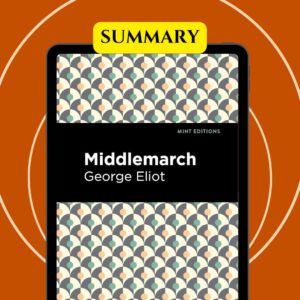Middlemarch summary
Middlemarch, published in 1871–1872, is a groundbreaking novel by the renowned Victorian author George Eliot.
The novel is set in the fictional town of Middlemarch and captures the intricacies of human nature and societal dynamics.
Overview of George Eliot
- George Eliot, the pen name of Mary Ann Evans, was a trailblazer in Victorian literature.
- Known for her realism and insightful portrayals of characters, Eliot’s writing style delves deep into the complexities of human emotions.
- Middlemarch is celebrated for its vivid characterization, moral depth, and rich narrative tapestry.
Significance as a Classic
- Middlemarch is considered a classic in English literature for its profound exploration of various themes like marriage, ambition, morality, and societal class structures.
- The novel’s enduring relevance lies in its ability to resonate with readers across generations, making it a timeless masterpiece.

Table of Contents
George Eliot: A Pioneer of Realism
Background and Influences
- George Eliot’s personal experiences and intellectual pursuits shaped her realistic portrayal of societal norms and human relationships.
- Her background as a journalist and translator provided her with a keen eye for detail and a deep understanding of human psychology.
Realism in the 19th Century
- Eliot’s embrace of realism as a literary movement marked a departure from the romantic ideals prevalent in her time.
- Realism aimed to depict life as it was lived, with a focus on the everyday struggles and triumphs of ordinary people.
Middlemarch as a Realist Masterpiece
- Middlemarch exemplifies Eliot’s commitment to realism through its meticulous character studies and social commentary.
- The novel presents a microcosm of society, portraying the ambitions, flaws, and triumphs of its diverse characters with unflinching honesty.
Setting and Time Period of Middlemarch
The Town of Middlemarch
- Middlemarch is set in a fictional English town that serves as a vibrant backdrop for the unfolding drama of the characters’ lives.
- The town’s social fabric and interconnected relationships play a pivotal role in driving the narrative forward.
Early 19th Century Context
- Against the backdrop of the early 19th century, Middlemarch captures the societal shifts, economic changes, and moral dilemmas of the era.
- The novel reflects the period’s ethos and challenges, offering a window into the complexities of Victorian society.
Shaping the Story and Characters
- The setting of Middlemarch not only establishes a vivid backdrop but also influences the characters’ choices, aspirations, and struggles.
- The town becomes a mirror reflecting the characters’ desires, failures, and moral quandaries, creating a rich tapestry of human experiences.
Plot Overview of Middlemarch
Main Plot Points
- Middlemarch follows the intertwined lives of several characters, each grappling with personal ambitions, societal expectations, and moral dilemmas.
- Key plotlines revolve around marriage, career aspirations, and the pursuit of fulfillment against societal constraints.
Key Characters and Relationships
- Characters like Dorothea Brooke, Tertius Lydgate, Edward Casaubon, and Rosamond Vincy drive the narrative with their distinct personalities and choices.
- Their relationships and interactions shape the course of the story, revealing the complexities of human nature and social dynamics.
Major Themes and Conflicts
- Middlemarch delves into themes of love, ambition, duty, morality, and class divisions, provoking profound reflections on human nature and society.
- The conflicts arising from these themes drive the narrative forward, culminating in poignant revelations and moral quandaries for the characters.
Adaptations and Influence of Middlemarch
- Middlemarch summary analysis reveals its significant influence on various adaptations across different media platforms.
- TV adaptations, including the BBC miniseries, have brought Middlemarch to a wider audience, capturing the essence of George Eliot’s narrative.
- Film adaptations have presented visual interpretations of the novel’s complex characters and themes.
- Theatre adaptations have creatively portrayed the intricate relationships and societal dynamics depicted in Middlemarch.
- The realism in these adaptations mirrors George Eliot’s intent to capture the nuances of human nature and society in her novel.
- The lasting impact of Middlemarch on popular culture is evident through its reimaginings in various artistic forms.
Comparison to Other Works by George Eliot
- Contrasting Middlemarch with George Eliot’s other novels highlights the evolution of her themes and writing style.
- Recurring themes like morality, social class, and personal growth can be observed across George Eliot’s body of work.
- The distinctive portrayal of complex relationships and societal issues sets Middlemarch apart within Eliot’s literary repertoire.
- George Eliot’s exploration of human nature and society remains a central focus in both Middlemarch and her other works.
- An analysis of the narrative techniques and character development in Eliot’s novels showcases her profound understanding of the human experience.
Middlemarch in the Context of 19th-Century Literature
- Comparing Middlemarch to other notable works of 19th-century literature underscores its enduring relevance and impact.
- The novel’s depiction of social and political issues resonates with the broader themes explored in 19th-century literary classics.
- Middlemarch serves as a reflection of the societal norms and values prevalent during the Victorian era.
- The novel’s exploration of marriage, ambition, and morality aligns with the thematic concerns of other prominent works of the time.
- The enduring legacy of Middlemarch within the canon of English literature underscores its status as a pivotal piece of 19th-century storytelling.
Key Takeaways from Middlemarch
- A Middlemarch summary analysis unveils key lessons and insights that resonate with readers across generations.
- The novel’s exploration of morality, ambition, and personal growth offers valuable insights into the complexities of human nature.
- Themes of love, sacrifice, and societal expectations provide a lens through which readers can examine their own beliefs and values.
- The enduring relevance of Middlemarch lies in its ability to provoke introspection and contemplation on timeless themes.
- Readers are encouraged to delve deeper into the intricate layers of Middlemarch to unearth the profound lessons embedded within its narrative.
Frequently Asked Questions (FAQs) About Middlemarch Summary:
What is the main theme of Middlemarch by George Eliot?
George Eliot’s Middlemarch delves into themes such as marriage, ambition, morality, and social class, exploring how these elements shape the lives of its characters and the society they inhabit.
Who are the main characters in Middlemarch and how do they contribute to the story?
Characters like Dorothea Brooke, Tertius Lydgate, Edward Casaubon, and Rosamond Vincy play significant roles in Middlemarch, each with unique motivations, personalities, and character arcs that interweave to drive the narrative forward.
What is the significance of the setting and time period in Middlemarch?
The fictional town of Middlemarch and the early 19th-century backdrop serve as crucial elements in shaping the story and characters, providing a rich and immersive environment for the unfolding drama.
How does George Eliot’s writing style contribute to the realism of Middlemarch?
George Eliot’s narrative style, characterized by its detailed portrayal of society and characters, aligns with the realism movement of the 19th century, giving Middlemarch a sense of authenticity and depth.
What are some key takeaways from Middlemarch for readers?
Middlemarch offers readers valuable insights into human nature, relationships, personal growth, and societal norms, making it a thought-provoking and enduring piece of literature with timeless lessons.
Conclusion:
In conclusion, Middlemarch by George Eliot stands as a seminal work in English literature, weaving together intricate themes, compelling characters, and a vivid portrayal of 19th-century society. Through its exploration of human desires, ambitions, and moral dilemmas, the novel continues to resonate with readers across generations. Delving into Middlemarch is not just an encounter with a classic novel, but an invitation to reflect on timeless truths and complexities that enrich our understanding of the human experience. Dive into Middlemarch to uncover its layers of meaning and immerse yourself in a world where characters grapple with life’s profound questions, leaving a lasting imprint on both literature and the hearts of its readers.





